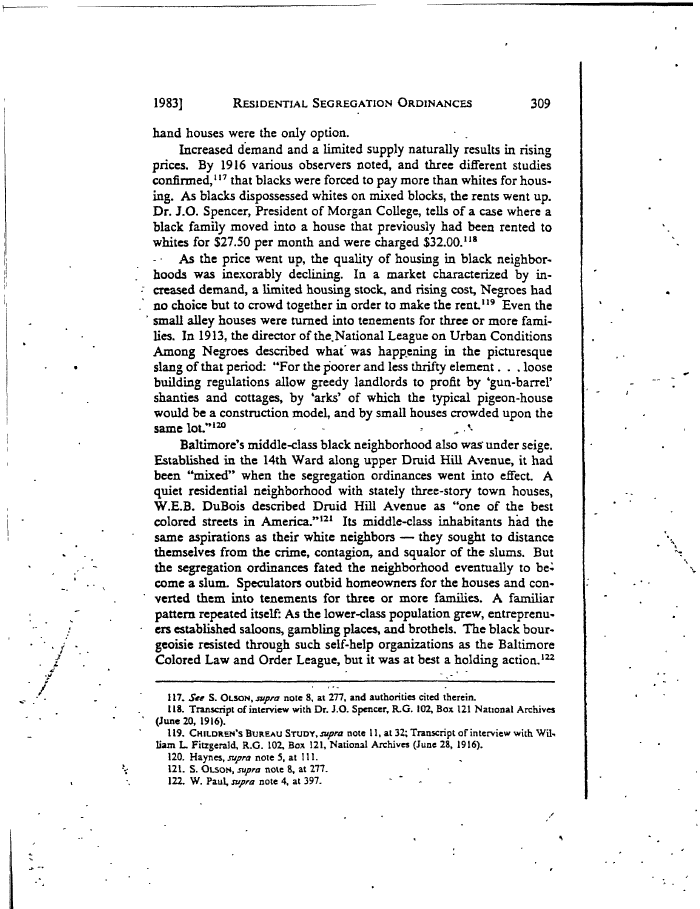 |
||||
|
Garrett Power, Apartheid Baltimore Style: The Residential Segregation Ordinances of 1910-1913, Maryland Law Review, 42 (1983) , Image No: 22 Enlarge and print image (64K) << PREVIOUS NEXT >> |
 |
||||
|
Garrett Power, Apartheid Baltimore Style: The Residential Segregation Ordinances of 1910-1913, Maryland Law Review, 42 (1983) , Image No: 22 Enlarge and print image (64K) << PREVIOUS NEXT >> |
| 1983] RESIDENTIAL SEGREGATION ORDINANCES 309 hand houses were the only option. • . Increased demand and a limited supply naturally results in rising prices. By 1916 various observers noted, and three different studies confirmed,117 that blacks were forced to pay more than whites for hous- ing. As blacks dispossessed whites on mixed blocks, the rents went up. Dr. J.O. Spencer, President of Morgan College, tells of a case where a black family moved into a house that previously had been rented to whites for $27.50 per month and were charged $32.00.118 As the price went up, the quality of housing in black neighbor- hoods was inexorably declining. In a market characterized by in- creased demand, a limited housing stock, and rising cost, Negroes had no choice but to crowd together in order to make the rent119 Even the small alley houses were turned into tenements for three or more fami- lies. In 1913, the director of the.National League on Urban Conditions Among Negroes described what was happening in the picturesque slang of that period: "For the poorer and less thrifty element. . .loose building regulations allow greedy landlords to profit by 'gun-barrel' shanties and cottages, by 'arks' of which the typical pigeon-house would be a construction model, and by small houses crowded upon the same lot."120 Baltimore's middle-class black neighborhood also was' under seige. Established in the 14th Ward along upper Druid Hill Avenue, it had been "mixed" when the segregation ordinances went into effect. A quiet residential neighborhood with stately three-story town houses, W.E.B. DuBois described Druid Hill Avenue as "one of the best colored streets in America.121 Its middle-class inhabitants had the same aspirations as their white neighbors — they sought to distance themselves from the crime, contagion, and squalor of the slums. But the segregation ordinances fated the neighborhood eventually to be- come a slum. Speculators outbid homeowners for the houses and con- verted them into tenements for three or more families. A familiar pattern repeated itself: As the lower-class population grew, entreprenu- ers established saloons, gambling places, and brothels. The black bour- geoisie resisted through such self-help organizations as the Baltimore Colored Law and Order League, but it was at best a holding action.122 117. See S. OLSON, supra note 8, at 277, and authorities cited therein. 118. Transcript of interview with Dr. J.O. Spencer, R.G. 102, Box 121 National Archives (June 20, 1916). 119. CHILDREN'S BUREAU STUDY, supra note 11, at 32; Transcript of interview with Wil- liam L. Fitzgerald, R.G. 102, Box 121, National Archives (June 28, 1916). 120. Haynes,supra note 5, at 111. 121. S. OLSON, supra note 8, at 277. 122. W. Paul, supra note 4, at 397. - |